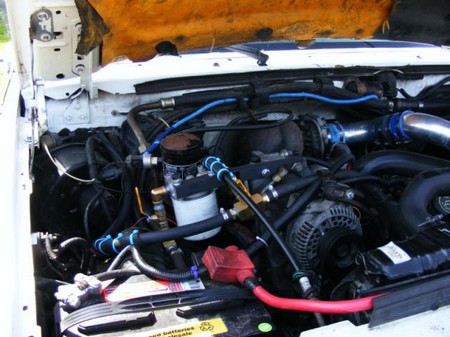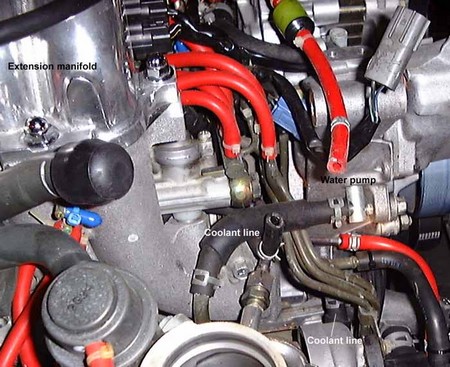Every vehicle has at least five cooling-system hoses. Some have six. All must remain intact; otherwise, an engine will lose coolant and overheat. Every vehicle has an upper radiator hose that transfers hot coolant from the engine to the radiator, and a lower radiator hose that transfers coolant from the radiator to the engine. Every vehicle also has two hoses that carry hot coolant to and away from the heater, and a coolant-recovery (overflow) hose.

The sixth hose on some engines is a bypass hose between the engine and the water pump. Its function is to direct coolant back into the engine when the engine is cold and the thermostat is closed. Engines without a bypass hose have an internal passage that directs coolant back into the engine when the thermostat is closed, blocking its path to the radiator.
Some automotive authorities recommend that hydraulic hoses be replaced every 60,000 miles. Others suggest that an inspection at 60,000 miles and every 10,000 miles thereafter is sufficient to spot a weak hose, which can then be replaced with a custom hydraulic hose. They contend that it is unnecessary to replace hydraulic hoses that are still usable.
If you decide to follow the latter suggestion, conduct the inspection with the engine cold. Examine both ends of a hose, around the clamps. Look for corrosive deposits, which indicate that the hose is starting to fail, allowing coolant to leak.
Squeeze the hose from one end to the other to determine whether there are cracks and also to feel the hose for firmness. A hose that feels “mushy” is a hose that is deteriorating internally.
Start the engine and let it warm up. Watch the hose. If a bulge forms, the hose should be replaced.
Follow these steps to replace a suspicious-looking hose and to change coolant that has weakened.
Coolant should be replaced every two years or after every 30,000 miles of driving, whichever occurs first. Allowing weak coolant to remain in use will result in corrosion buildup in the cooling system. Corrosion can clog tubes in the radiator, causing the engine to overheat.
- Let the engine get cold.
- Place a large pan under the radiator drain valve, which is called the petcock.
- Remove the radiator cap by pressing down and turning.
- Open the petcock.
- When coolant stops flowing, close the petcock.
- Loosen clamps holding the ends of the defective hose and slide them from place. You will discard the used clamps, so there is no need to treat them gently. You can, in fact, cut them off.
- Twist the end of the hose back and forth to release it from the fitting. If the hose sticks to the fitting and doesn’t come off, cut lengthwise slits around the entire perimeter of the hose with a utility knife. Be careful not to cut into the fitting. Then, using a screwdriver, peel the pieces of hose off the fitting.
- When the hose has been removed and discarded, use a wire brush to clean both fittings.
- You are now ready to install the new hose, which should be the same length as the old hose. Place new clamps on the new hose. Then, soak the ends of the hose in hot water. This makes the hose pliable so that the ends can be pushed more easily onto the fittings.
- When the new hose is in place, slide the clamps into position, leaving a ‘A-inch gap between the ends of the hose and the edges of the clamps. Do not place the clamps right on the ends of the hose. Doing so may cause the hose to bulge at this point and release coolant.
- Tighten clamps but don’t ram them down.
- Fill the radiator with a fresh coolant mixture consisting of half ethylene glycol and half water. A 50:50 ratio protects engines to a temperature of about -20°F. If a lower temperature than this is anticipated for your part of the country, check the owner’s manual for the proper ratio or ask at an auto parts store. Do not exceed a ratio of 68 percent ethylene glycol to 32 percent water, which will protect an engine to about -90°F. Once this ratio is exceeded, the protection factor reverses itself. In fact, using full-strength ethylene glycol in an engine provides protection only to about -8°F.
- Put on and tighten the radiator cap.
- Fill the coolant-recovery tank with coolant to the COLD mark.
- Start the engine and let it run for two minutes. Turn it off and check around the ends of the hose. If coolant is leaking, tighten the clamp a bit more. Repeat this procedure until the leak stops.









